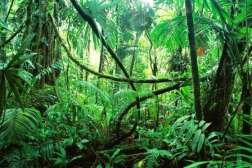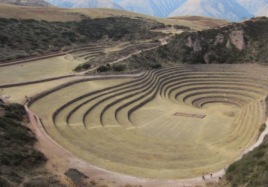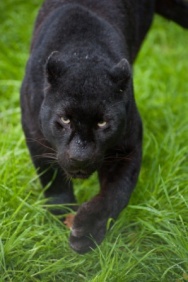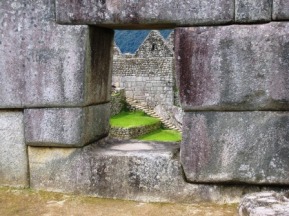A fellow paqo and former student recently wrote me about an online teaching he attended with two Q’ero paqos about salka and atiy energies that he found intriguing and informative. He reviewed a bit of the material with me and asked for my perspective. I thought this subject would make a good blog post. But before I dive  into the subject and offer my own perspective, I need to define and explain a few relevant terms.
into the subject and offer my own perspective, I need to define and explain a few relevant terms.
Salka (salqa) means “selva” in Spanish and “jungle” in English. Overall it refers metaphorically to wildness, but its meaning has two distinct “flavors.” At one end of the spectrum, you experience salka as a natural and even primal life force. You express this energy by being spontaneous, original, unbridled, even daring. It’s a passion expressed through actions, an approach to life involving joyful abandon. It’s a personality style that drives you beyond familial or societal norms to express yourself without an overarching desire for approval or acceptance. It goes beyond intellect and emotion to a visceral, physical immersion in life. At the other end of the spectrum, salka is wildness that stays dark and goes deep, so it is mostly beyond your awareness. This salka is the energy of the hidden self, of the personal shadow, of impulses that drive your thoughts, words, and deeds in ways beyond your conscious choice. When left unchecked, this energy can be the cause of hucha, and it can even wreak havoc in your life.
Atiy refers to the capacity of the siki ñawi, the mystical “eye” or energy center at the base of the spine; this is the eye of the black belt, or yana chunpi. Atiy refers to personal power: to having the ability to take action or to overcome a challenge. Atini means “I can do it.” In the Andean mystical tradition, the capacity of atiy at the siki ñawi refers to an awareness of measuring your power, of determining how much power you have to undertake something you want to do. It also refers to determining proper timing of that action, where undertaking the action at the most opportune time increases your chance for success. Finally, the siki ñawi and yana chunpi are the places of impulses, of your baser, instinctual, and impulsive self. Impulse here refers to both core human needs (such as survival, food, nurturing) as well as the unconscious aspects of your “shadow self,” the hidden (or denied) psychological self that is a frothing cauldron of impulses that drive your thoughts, opinions, beliefs, responses, behaviors and more.
As you can see, salka and atiy can be yoked together to produce a powerful energy within the self, linking passion and action. But I want to make one more distinction—provide an important contrast—before I talk about this. At our qosqo ñawi, the eye of the puka chunpi (red belt) at the belly, we have the capacity for khuyay, passion. How is this passion at the qosqo ñawi different from the passion of salka, which some paqos are linking to atiy at the siki ñawi? Khuyay is passionate and mindful engagement; it is the intensity of connection of two lovers looking into each others’ eyes; it is the one-pointed immersion of attention and joy of a child at play; it is the perfect synchronization of a jazz trio making spontaneous music together. In contrast, salka is the more unconscious, unmediated wildness of your expressions and actions. You might say it is action that is less disciplined and defined, less shaped and understood. It tends to be reactive, and so too often is outside the realm of choice. I urge you to not confuse the two kinds of “passion”—salka (even in its healthy aspect) and khuyay— as the distinction is important to this discussion.
From what my fellow paqo and former student told me, in the online discussion the Q’ero paqos were speaking of salka as a powerful but largely hidden power. They also related it to animal spirits, such as the puma, hummingbird, condor, and serpent. If you seek this natural, wild, and passionate power, they said, you will find it. And you can, upon mastery of that power, link it with your atiy—your action in the world—to become a tukuyatiynioq: a total owner of atiy. I find all of this a beautiful rendering of one aspect of atiy, in a way I had not heard before.
But I would like to extend the discussion, admitting that I was told only a little about what the paqos said. I would like to tease out other meanings and applications of salka and atiy, and move beyond having to work with spirit beings, animal or otherwise. All power is within us, and that is how I would like to extend the discussion here.
I will begin by discussing salka as a step up an evolutionary path. (So that I don’t have to repeat myself in too much detail here, I refer you to an earlier post for more about salka: “Bridge Between the Worlds,” September 30, 2016.) My teacher don Juan Nuñez el Prado has discussed salka in relation to the Inkas. Very briefly, salka generally was thought of as wild in the sense of underdeveloped or undomesticated. The Inka were all about organization and improvement of what was wild, out of control, or unhelpful in nature. They did not seek to dominate nature, but to work in partnership with nature to undertake a process called mast’ay. Mast’ay means to structure, reorder, reorganize. Nature left to itself provided a harsh and unforgiving environment for humans to live in. It was difficult to thrive. As human culture developed, including the introduction of farming and domestication of animals, nature was remade in a way that was more organized and less wild. The Inkas perfected the art of irrigation and water rerouting, and of terracing mountainsides to grow crops, and such. They were reducing the wildness of nature and bringing greater organization to it for the benefit of human well-being. So, in this sense salka is a step down on the evolutionary path. Nature in its wildness is not amenable to human life; nature made more domesticated is. That’s the very general metaphor and actual process of human physical and cultural evolution. (We have gone to an extreme today, dominating and even destroying nature.)
about salka: “Bridge Between the Worlds,” September 30, 2016.) My teacher don Juan Nuñez el Prado has discussed salka in relation to the Inkas. Very briefly, salka generally was thought of as wild in the sense of underdeveloped or undomesticated. The Inka were all about organization and improvement of what was wild, out of control, or unhelpful in nature. They did not seek to dominate nature, but to work in partnership with nature to undertake a process called mast’ay. Mast’ay means to structure, reorder, reorganize. Nature left to itself provided a harsh and unforgiving environment for humans to live in. It was difficult to thrive. As human culture developed, including the introduction of farming and domestication of animals, nature was remade in a way that was more organized and less wild. The Inkas perfected the art of irrigation and water rerouting, and of terracing mountainsides to grow crops, and such. They were reducing the wildness of nature and bringing greater organization to it for the benefit of human well-being. So, in this sense salka is a step down on the evolutionary path. Nature in its wildness is not amenable to human life; nature made more domesticated is. That’s the very general metaphor and actual process of human physical and cultural evolution. (We have gone to an extreme today, dominating and even destroying nature.)
I have said so many times that our Andean mystical path is a path of personal and collective evolution, moving up the stairway of consciousness from the zero level to the seventh level (from absolute dependency and no sense of self, like an infant, to the full revelation of being equivalent to God in human form). This is a path of power. It is a path, if you will, of atiy: of human action in the world.
Your karpay is your full amount power at the current time. Atiy is how you sensitize yourself to seeing reality as it really is in terms of how much personal power you have at the current time. Do you have enough personal power to carry out your intentions? If not, where are you lacking? Atiy also is bringing your impulses (as in your shadow self) to consciousness and, thus, under your will. When your impulses are not under your will, you tend to be impetuous, reactive, hasty, brash, and even reckless. So, if you are too salka—too hidden from yourself, too wild and uncontrolled in your impulses and, hence, with your power—you can be said to be less organized within the self, less able to consciously use your power. Your whole life will be affected because you will have less of a sense of your atiy.
Another aspect of salka and atiy involves the three worlds. You have the three worlds within you: a personal heaven or hanaqpacha (upper world) and a personal unconscious or ukhupacha (lower or inner world). Your personal kaypacha—your human life—reflects how well you integrate the inner upper world (enlightened self) and inner lower world (hidden, unconscious, shadow, impulsive self). The lower world, the ukhupacha, is a place of regeneration. It is the place you go to see with clarity the hucha you are generating and your lack of understanding of ayni. Through this awareness you then can make a choice to transform your hucha and improve your ayni. When you do, there is much less about yourself that you hide from yourself. You bring awareness to your deep emotional and psychological self and begin re-ordering your personal lower or inner world. This is a powerful mast’ay that leads to a quickening evolution of the self.
The animal spirits relate to these three worlds if you consider them metaphorically and energetically. The “totem” of the upper world used to be the condor and at some time in the past shifted to the hummingbird. The inner upper world is your inner divinity, your perfected and enlightened self that expresses only sami and practices perfect ayni. The condor is the eater of hucha (heavy energy), whereas the hummingbird is the bringer of sami (light living energy). Your work is twofold. First, getting your inner wildness under control involves both seeing and owning where you are creating hucha and then transforming (eating) your hucha. This is the work of your inner condor. When you have less hucha, you have more sami available to bring to the world, and you can consciously spread your sami as the work of your inner hummingbird.
The animal spirit of the lower world is the amaru, or anaconda/snake. It metaphorically heralds your ability to go deep into your salka or hidden self—your inner lower world of the subconscious—and begin the work of regenerating yourself. You shed the skin of your old impulsive and reactive self and take on the new skin of making conscious choices and taking conscious action. (As an aside:  Impulses in and of themselves are not negative or bad. Impulses can be seen simply as the energy to do something. But hidden salka impulses can be the content of your shadow self, the repressed energies you keep hidden from yourself and that drive you without your conscious awareness. There is little personal power involved in that kind of impulse energy.)
Impulses in and of themselves are not negative or bad. Impulses can be seen simply as the energy to do something. But hidden salka impulses can be the content of your shadow self, the repressed energies you keep hidden from yourself and that drive you without your conscious awareness. There is little personal power involved in that kind of impulse energy.)
The way your upper and lower worlds are aligned with each other (integrated or not) at least partly determines the condition of your kaypacha, your human life. The kaypacha is represented by the puma. After integration of the upper and lower inner worlds you identify not with the hidden, wild otorango of the jungle, but with the mountain puma, who lives closer to human communities. You move from your wild self to your more human, domesticated self. Or, to put it another way, you can transform your salka energy from uncontrolled and unconscious impulse to a thriving, passionate engagement in life.
All of this discussion brings us to qaway—mystical vision, seeing reality as it really is. The three uppermost ñawis are the two physical eyes and the seventh eye. You must learn to see the reality of your physical world and human self without the overlay of your desires, opinions, stories, and projections. At the same time, you must learn to see the reality of your energetic self, of your potential to be a perfected, enlightened human being. This is an integration process—a mast’ay—of the physical and metaphysical understanding of yourself. The process can start many ways, one of which is through developing your qaway to determine how salka (wild, not under your control) your atiy (ability to use your power) is. How reactive, impulsive, unthinking, even reckless are your thoughts, words, or actions when you are emotionally or psychologically triggered? The more you find yourself at the mercy of those salka impulses, the more hidden from yourself you are and the less ability you have to make actual choices for yourself. Your work is to bring those unruly salka aspects of yourself to the light of awareness (qaway) so that you can consciously sort out what is mindfully engaged passion (khuyay) and what is unthinking impulsivity (salqa). By doing so, you can increase your inner mast’ay and thus your atiy (what you choose to do in life and how you choose to apply your intention and energy).
If you can do that work, you also will discover that your impulses won’t be trapped at your siki ñawi. You can consciously move those impulses once they arise in the siki ñawi up through your other centers and ñawis, bringing other capacities—such as munay (love) and rimay (clarity of action, whether in your thoughts, emotions, words or deeds—to that impulse. You can then mediate the energy of that impulse, transforming it so that it is less hucha-inducing and more sami-producing. You can eventually evolve your salka energy to the level of khuyay, the capacity at the belly to experience a healthy and directed passion instead of an impulsive, undirected wildness. In that way, you move closer to becoming a tukuyatiynioq—a total owner of your ability to know your power and express it beneficially in the  world.
world.
You don’t need to work with animal spirits to do this inner work. You need to work with your own inner salka “animal” self. Evolutionarily we were once one step above wild animals. But we have evolved to becomes creatures of amazing complexity, creativity, insight, self-awareness, and more. This biological evolution, now more or less complete, has morphed to an evolution of conscious: to moving up the qanchispatañan, or stairway of seven steps of consciousness. Part of this process is morphing unconscious impulsivity (salka) into focused and joyful passion (khuyay). Then infusing your atiy with this passion to express yourself and engage with life in a gloriously authentic way.

This is great, Joan. Thank you for sharing. 🌹
On Mon, Jul 20, 2020, 4:20 PM Q’enti Wasi – House of the Hummingbird wrote:
> Q’enti Wasi posted: “A fellow paqo and former student recently wrote me > about an online teaching he attended with two Q’ero paqos about salka and > atiy energies that he found intriguing and informative. He reviewed a bit > of the material with me and asked for my perspective. I ” >
LikeLike